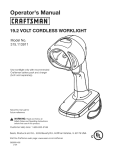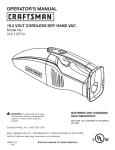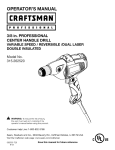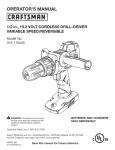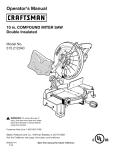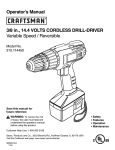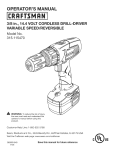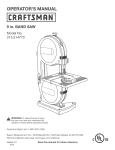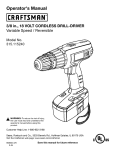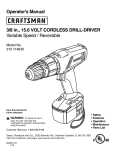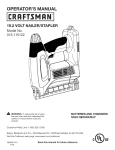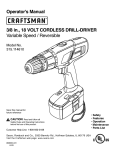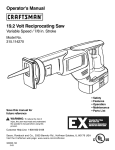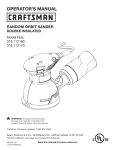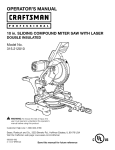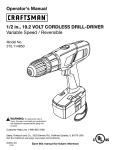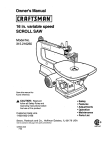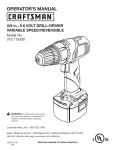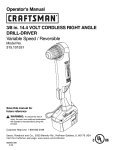Download Craftsman 315.115820 Operator`s manual
Transcript
RATOR'S MANUAL 19.2 VOLT CUT-OUT SAW Model No. 315.115820 A BATTERIES AND CHARGER SOLD SEPARATELY WARNING: To reduce the risk of injury, the user must read and understand the operator's manual before using this product. Customer Help Line: 1-800-932-3188 Sears, Roebuck and Co., 3333 Beverly Rd., Hoffman Estates, IL 60179 USA Visit the Craftsman web page: www.sears.com/craftsman 983000-784 09-18-06 (REV:01) Save this manual for future reference • Warranty .......................................................................................................................................................................... 2 • Introduction ..................................................................................................................................................................... 2 • General Safety Rules .................................................................................................................................................... • Specific Safety Rules ....................................................................................................................................................... 4 • Safety Rules for Charger ................................................................................................................................................. 5 • Symbols ........................................................................................................................................................................ • Features ........................................................................................................................................................................... 8 • Assembly ......................................................................................................................................................................... 9 • Operation .................................................................................................................................................................. • Maintenance .................................................................................................................................................................. 15 • Exploded View and Parts List ........................................................................................................................................ 16 • Parts Ordering/Service .................................................................................................................................... ONE YEAR FULL WARRANTY ON CRAFTSMAN 3-4 6-7 10-14 Back Page TOOL If this Craftsman tool fails to give complete satisfaction within one year from date of purchase, RETURN IT TO THE NEAREST SEARS STORE IN THE UNITED STATES, and Sears will replace it, free of charge. if this Craftsman tool is used for commercial purchase. or rental purposes, this warranty applies for only 90 days from the date of This warranty gives you specific legal rights, and you may also have other rights which vary from state to state. Sears, Roebuck and 0o., Dept. 817 WA, Hoffman Estates, (L 60179 This tool has many features for making its use more pleasant and enjoyable. Safety, performance, and dependability have been given top priority in the design of this product making it easy to maintain and operate. ,_ WARNING! Read all instructions. Failure to follow all instructions listed below may result in electric shock, fire and/or serious injury. The term "power tool" in all of the warnings listed below refers to your mains-operated (corded) power tool or battery-operated (cordless) power tool. SAVE THESE WORK INSTRUCTIONS AREA SAFETY [] Keep work area clean and well lit. Cluttered or dark areas invite accidents. [] Do not operate power tools in explosive atmospheres, such as in the presence of flammable liquids, gases or dust. Power tools create sparks which may ignite the dust or fumes. [] Keep children and bystanders away while operat= ing a power tool. Distractions can cause you to lose control. ELECTRICAL SAFETY [] Power tool plugs must match the outlet. Never modify the plug in any way. Do not use any adapter plugs with earthed (grounded) power tools. Unmodified plugs and matching outlets will reduce risk of electric shock. [] Avoid body contact with earthed or grounded surfaces such as pipes, radiators, ranges and refrigerators. There is an increased risk of electric shock if your body is earthed or grounded. [] Do not expose power tools to rain or wet condi= tions. Water entering a power tool will increase the risk of electric shock. [] Do not abuse the cord. Never use the cord for carrying, pulling or unplugging the power tool. Keep cord away from heat, oil, sharp edges or moving parts. Damaged or entangled cords increase the risk of electric shock. [] When operating a power tool outdoors, use an extension cord suitable for outdoor use. Use of a cord suitable for outdoor use reduces the risk of electric shock. [] Use battery MODEL 315.115820 PERSONAL only with charger listed. BATTERY PACK CHARGER 130279003 Model No. 1425301 130279005 (Item No. _911041) (Item No. _911375) Model No. 315.115730 (Item No. 140301003) SAFETY [] Stay alert, watch what you are doing and use common sense when operating a power tool. Do not use a power tool while you are tired or under the influence of drugs, alcohol or medication. A moment of inattention while operating power tools may result in serious personal injury. [] Use safety equipment. Always wear eye protection. Safety equipment such as dust mask, non-skid safety shoes, hard hat, or hearing protection used for appropriate conditions will reduce personal injuries. [] Avoid accidental starting. Ensure the switch is in the off=position before plugging in. Carrying power tools with your finger on the switch or plugging in power tools that have the switch on invites accidents. [] Remove any adjusting key or wrench before turning the power tool on. A wrench or a key left attached to a rotating part of the power tool may result in personal injury. [] Do not overreach. Keep proper footing and balance at all times. This enables better control of the power tool in unexpected situations. [] Dress properly. Do not wear loose clothing or jew= elry. Keep your hair, clothing and gloves away from moving parts. Loose clothes, jewelry, or long hair can be caught in moving parts. [] if devices are provided for the connection of dust extraction and coflection facilities, ensure these are connected and properly used. Use of these devices can reduce dust-related hazards. [] Do not wear loose clothing or jewelry. Contain long hair. Loose clothes, jewelry, or long hair can be drawn into air vents. [] Do not use on a ladder or unstable support. Stable footing on a solid surface enables better control of the power tool in unexpected situations. POWER TOOL USE AND CARE [] Do not force the power tooL Use the correct power tool for your application. The correct power tool will do the job better and safer at the rate for which it was designed. [] Do not use the power tool if the switch does not turn it on and off. Any power tool that cannot be controlled with the switch is dangerous and must be repaired. [] Disconnect the plug from the power source and/or the battery pack from the power tool before making any adjustments, changing accessories, or storing power tools. Such preventive safety measures reduce the risk of starting the power tool accidentally. [] Store idle power tools out of the reach of children and do not allow persons unfamiliar with the power tool or these instructions to operate the power tool. Power tools are dangerous in the hands of untrained users. [] Maintain power tools. Check for misalignment or binding of moving parts, breakage of parts, and any other condition that may affect the power tool's operation, if damaged, have the power tool repaired before use. Many accidents are caused by poorly maintained power tools. [] Keep cutting tools sharp and clean. Properly maintained cutting tools with sharp cutting edges are less likely to bind and are easier to control. [] Use the power tool, accessories and tool bits etc., in accordance with these instructions and in the manner intended for the particular type of power tool, taking into account the working conditions and the work to be performed. Use of the power tool for operations different from those intended could result in a hazardous situation. BATTERY TOOL USE AND CARE [] Ensure the switch is in the off position before insetting battery pack. Inserting the battery pack into power tools that have the switch on invites accidents. [] Recharge only manufacturer. of battery pack another battery with the charger specified by the A charger that is suitable for one type may create a risk of fire when used with pack. [] Use power tools only with specifically designated battery packs. Use of any other battery packs may create a risk of injury and fire. [] When other nails, make battery pack is not in use, keep it away from metal objects like paper clips, coins, keys, screws, or other small metal objects that can a connection from one terminal to another. [] Use auxiliary handle supplied with the tool. Loss of control can cause personal injury. [] Hold power tools by insulated gripping surfaces when performing an operation where the cutting tool may contact hidden wiring or its own cord. Contact with a "live" wire will also make exposed metal parts of the tool "live" and shock the operator. [] Know your power tool. Read operator's manual carefully. Learn its applications and limitations, as well as the specific potential hazards related to this power tool. Following this rule will reduce the risk of electric shock, fire, or serious injury. [] Always wear safety glasses with side shields. Everyday glasses have only impact resistant lenses. They are NOT safety glasses. Following this rule will reduce the risk of eye injury. [] Protect your lungs. Wear a face or dust mask if the operation is dusty. Following this rule will reduce the risk of serious personal injury. [] Protect your hearing. Wear hearing protection during extended periods of operation. Following this rule will reduce the risk of serious personal injury. [] Battery tools do not have to be plugged into an electrical outlet; therefore, they are always in operating condition. Be aware of possible hazards when not using your battery tool or when changing accessories. Following this rule will reduce the risk of electric shock, fire, or serious personal injury. [] Do not place battery tools or their batteries near fire or heat. This will reduce the risk of explosion and Shorting the battery terminals together may cause burns or a fire. Under abusive conditions, liquid may be ejected from the battery, avoid contact, if contact acci= dentally occurs, flush with water. If liquid contacts eyes, additionally seek medical help. Liquid ejected from the battery may cause irritation or burns. SERVICE [] Have your power tool serviced by a qualified repair person using only identical replacement parts. This will ensure that the safety of the power tool is maintained. _, WARNING! To reduce the risk of injury, user must read instruction manual. [] When servicing a power tool, use only identical replacement parts. Follow instructions in the Maintenance section of this manual. Use of unauthorized parts or failure to follow Maintenance instructions create a risk of shock or injury. may possibly injury. [] Never use a battery that has been dropped or received a sharp blow. A damaged battery is subject to explosion. Properly dispose of a dropped or damaged battery immediately. [] Batteries vent hydrogen gas and can explode in the presence of a source of ignition, such as a pilot light. To reduce the risk of serious personal injury, never use any cordless product in the presence of open flame. An exploded battery can propel debris and chemicals. If exposed, flush with water immediately. [] Do not charge battery tool in a damp or wet location. Following this rule will reduce the risk of electric shock. [] For best results, your battery tool should be charged in a location where the temperature is more than 50°F but less than 100°F. Do not store outside or in vehicles. [] Under extreme usage or temperature condi= tions, battery leakage may occur, if liquid comes in contact with your skin, wash immediately with soap and water, then neutralize with lemon juice or vinegar, if liquid gets into your eyes, flush them with clean water for at least 10 minutes, then seek immediate medical attention. Following this rule will reduce the risk of serious personal injury. [] Use clamps or another practical way to secure and support the workpiece to a stable platform. Holding the work by hand or against your body leaves it unstable and may lead to loss of control. A WARNING! READ AND UNDERSTAND ALL INSTRUCTIONS. Failure to follow all instructions listed below, may result in electric shock, fire and/or serious personal injury. [] Before using battery charger, read all instructions and cautionary markings in this manual, on battery charger, battery, and product using battery to prevent misuse of the products and possible injury or damage. a. That pins on plug of extension cord are the same number, size and shape as those of plug on charger. b. That extension cord is properly wired and in good electrical condition; and c. That wire size is large enough for AC ampere rating of charger as specified below: CAUTION: To reduce the risk of electric shock or Cord Length (Feet) 25' 50' 100' damage to the charger and battery, charge only nickel-cadmium rechargeable batteries as specifically designated on your charger. Other types of batteries may burst, causing personal injury or damage. Cord Size (AWG) 16 16 16 [] Do not use charger outdoors or expose to wet or damp conditions. Water entering charger will increase the risk of electric shock. [] Use of an attachment not recommended or sold by the battery charger manufacturer may result in a risk of fire, electric shock, or injury to persons. Following this rule will reduce the risk of electric shock, fire, or serious personal injury. [] Do not abuse cord or charger. Never use the cord to carry the charger. Do not pull the charger cord rather than the plug when disconnecting from receptacle. Damage to the cord or charger could occur and create an electric shock hazard. Replace damaged cords immediately. [] Make sure cord is located so that it will not be stepped on, tripped over, come in contact with sharp edges or moving parts or otherwise subjected to damage or stress. This will reduce the risk of accidental falls, which could cause injury, and damage to the cord, which could result in electric shock. [] Keep cord and charger from heat to prevent damage to housing or internal parts. [] Do not let gasoline, oils, petroleum-based products, etc. come in contact with plastic parts. They contain chemicals that can damage, weaken, or destroy plastic. [] An extension cord should not be used unless absolutely A could result in a risk of fire and electric shock. If extension cord must be used, make sure: necessary. NOTE: AWG = American Wire Gauge [] Do not operate charger with a damaged cord or plug, which could cause shorting and electric shock. If damaged, have the charger replaced by an authorized serviceman. [] Do not operate charger if it has received a sharp blow, been dropped, or otherwise damaged in any way. Take it to an authorized serviceman for electrical check to determine if the charger is in good working order. [] Do not disassemble charger. Take it to an authorized serviceman when service or repair is required. Incorrect reassembly may result in a risk of electric shock or fire. [] Unplug charger from outlet before attempting any maintenance or cleaning to reduce the risk of electric shock. [] Disconnect charger from the power supply when not in use. This will reduce the risk of electric shock or damage to the charger if metal items should fall into the opening. It also will help prevent damage to the charger during a power surge. [] Risk of electric shock. Do not touch uninsulated portion of output connector or uninsulated battery terminal. [] Save these instructions. Refer to them frequently and use them to instruct others who may use this tool. If you loan someone this tool, loan them these instructions also to prevent misuse of the product and possible injury. Use of improper extension cord WARNING: Some dust created by power sanding, sawing, grinding, drilling, and other construction activities contains chemicals known to cause cancer, birth defects or other reproductive harm. Some examples of these chemicals are: • lead from lead-based paints, crystalline silica from bricks and cement and other masonry products, and arsenic and chromium from chemically-treated lumber. Your risk from these exposures varies, depending on how often you do this type of work. To reduce your exposure to these chemicals: work in a well ventilated area, and work with approved safety equipment, such as those dust masks that are specially designed to filter out microscopic particles. Someofthefollowingsymbolsmaybeusedonthistool.Pleasestudythemandlearntheirmeaning.Properinterpretationof thesesymbolswillallowyoutooperatethetoolbetterandsafer. SYMBOL _ DESIG NATION/EXPLANATION V Volts Voltage A Amperes Current Hz Hertz Frequency (cycles per second) W Watt Power min Minutes Time "L, Alternating Current Type of current .-'= Direct Current Type or a characteristic of current no No Load Speed Rotational speed, at no load [] Class II Construction Double-insulated Per Minute Revolutions, strokes, surface speed, orbits etc., per minute Wet Conditions Alert Do not expose to rain or use in damp locations. Read The Operator's Manual operator's manual before To reduce the risk of injury,using user this mustproduct. read and understand .../min O NAME Eye Protection construction Always safety when goggles or safetythisglasses with side shields, or a full wear face shield operating product. Safety Alert Precautions that involve your safety. No Hands Symbol serious personal injury. Failure to keep your hands away from the blade will result in No Hands Symbol Failure to keep your hands away from the blade will result in serious personal injury. No Hands Symbol Failure to keep your hands away from the blade will result in serious personal injury. No Hands Symbol Hot Surface Failure to keep your hands away from the blade will result in serious personal injury. To hot reduce surface.the risk of injury or damage, avoid contact with any 6 Thefollowingsignalwordsandmeanings areintendedto explainthe levelsofriskassociatedwiththis product. SYMBOL SIGNAL MEANING ,_ DANGER: Indicates an imminently hazardous situation, which, if not avoided, will result in death or serious injury. ,_ WARNING: Indicates a potentially hazardous situation, which, if not avoided, could result in death or serious injury. CAUTION: Indicates a potentially hazardous situation, which, if not avoided, may result in minor or moderate injury. CAUTION: (Without Safety Alert Symbol) Indicates a situation that may result in property damage. SERVICE Servicing requires extreme care and knowledge and should be performed only by a qualified service technician. For service we suggest you return the product to your nearest AUTHORIZED SERVICE CENTER for repair. When servicing, use only identical replacement parts. ,_ _ WARNING: To avoid serious personal injury, do not attempt to use this product until you read thoroughly and understand completely the operator's manual. Save this operator's manual and review frequently for continuing safe operation and instructing others who may use this product. WARNING: O The operation of any power tool can result in foreign objects being thrown into your eyes, which can result in severe eye damage. Before beginning power tool operation, always wear safety goggles or safety glasses with side shields, or a full face shield when needed. We recommend Wide Vision Safety Mask for use over eyeglasses or standard safety glasses with side shields. Always use eye protection which is marked to comply with ANSI Z87.1. SAVE THESE iNSTRUCTiONS PRODUCT SPECIFICATIONS Motor ............................................................... 19.2 Volt DC No Load Speed ................................................ Charger Input ................................... 22,500/rain. Charge Rate ............................................................. Collet ............................................................. 1 hour 1/8 in., 1/4 in. 120 V, 60 Hz, AC only AUXILIARY HANDLE DEPTH ADJUSTMENT RING SWITCH SPINDLE LOCK COLLETNUT HEXKEY HEX KEY 8TORAGEAREA ADJUSTINGKNOB KNOW YOUR CUT-OUT See Figure 1. SAW Before attempting to use this product, familiarize yourself with all operating features and safety rules. AUXILIARY HANDLE Fig. 1 ERGONOMIC DESIGN The design of your cut-out saw provides for easy handling and maintaining proper control when cutting. It has been designed to be comfortable and easy to grasp when operating in different positions or at different angles. Your saw is equipped with an auxiliary handle for ease of operation and to aid of control in difficult operations. HEX KEY STORAGE Convenient wrench storage for quick auxiliary handle changes. CIRCLE SPINDLE CUTTER The circle cutter enables you to quickly cut circles from 3 1/2 in. diameter to 12 in. diameter. DEPTH ADJUSTMENT RING Your speed saw is equipped with a depth adjustment ring that allows you to adjust the depth of cut up to 1 in. LOCK A spindle lock secures the spindle and allows you to easily loosen the collet nut and change bits. NOTE: Do not run cut-out saw with spindle lock engaged. UNPACKING Thisproducthasbeenshippedcompletelyassembled. [] Carefully removethetoolandanyaccessories fromthe box.Makesurethatallitemslistedinthepackinglist areincluded. [] Inspectthetoolcarefullyto makesurenobreakage or damageoccurredduringshipping. [] Donotdiscardthepackingmaterialuntilyouhave carefullyinspectedandsatisfactorily operatedthetool. [] If anypartsaredamagedor missing,pleasecall 1-800-932-3188 forassistance. PACKINGLiST INSTALLING/REMOVING ASSEMBLY AUXILIARY See Figure 2. An auxiliary handle is packed with operation and to help prevent loss handle cap has also been supplied handle slot when the handle is not HANDLE the saw for ease of of control. An auxiliary to cover the auxiliary in use. To install auxiliary handle: [] Remove hex key from hex key storage area. [] Remove auxilary handle cap (if attached) by removing auxilary handle cap screws with hex key. [] Insert auxiliary handle into slot. Cut-Out Saw with 1/8 in. collet [] Install and tighten screws through slots on the auxiliary handle into cut-out saw with hex key. 1/4 in. collet [] Insert hex key back into hex key storage area. 1/8 in. collet To remove auxiliary Auxiliary Handle [] Remove hex key from hex key storage area. Auxiliary Handle Cap [] Remove screws in auxiliary handle with hex key. Auxiliary Handle Screws (2) [] Remove auxiliary handle and replace with auxiliary handle cap. 1/8 in. Drywall Bit handle: Circle Guide [] Install and tighten screws through slots on the auxiliary cap into cut-out saw with hex key. Wrench [] Insert hex key back into hex key storage area. Hex Key NOTE: Always hold the tool by its motor housing or the auxiliary handle. 1/8 in. Plywood Bit Operator's Manual _L A A WARNING: If any parts are missing do not operate this tool until the missing parts are replaced. Failure to do so could result in possible serious personal injury. WARNING: Do not attempt to modify this tool or create accessories not recommended for use with this tool. Any such alteration or modification is misuse and could result in a hazardous condition leading to possible serious personal injury. WARNING: To prevent accidental starting that could cause serious personal injury, always remove the battery pack from the tool when assembling parts. REMOVE CAP AUXILIARY HANDLE SCREW Fig. 2 A A A CHARGING WARNING: Do not allow familiarity with tools to make you careless. Remember that a careless fraction of a second is sufficient to inflict serious injury. NOTE: Batteries will not reach full charge the first time they are charged. Allow several cycles (operation followed by recharging) for them to become fully charged. CHARGING WARNING: Do not use any attachments or accessories not recommended by the manufacturer of this tool. The use of attachments or accessories not DANGER: PACK Battery packs for this tool are shipped in a low charge condition to prevent possible problems. Therefore, you should charge it until the green LED on the front of the charger comes on. WARNING: Always wear safety goggles or safety glasses with side shields when operating tools. Failure to do so could result in objects being thrown into your eyes, resulting in possible serious injury. recommended THE BATTERY A COOL BATTERY PACK If battery pack is below normal temperature range, the green LED on charger will come on. Allow battery pack to reach normal temperature, then the red LED will come on. can result in serious personal injury. NOTE: If the charger does not charge the battery pack under normal circumstances, return both the battery pack and charger to your nearest Bears Repair Center for electrical check. Do not cut electrical outlet openings with live electrical wires. Do not cut walls that may have live electrical wiring behind them. Shut off breakers or remove fuses to disconnect the circuit. [] Charge the battery pack only with the charger provided. APPLNCATIONS [] Make sure the power supply is normal household voltage, 120 volts, 60 Hz, AC only. You may use this tool for the following purposes: [] Connect the charger to the power supply. [] Cutting electrical outlet openings in drywall or wood paneling. It is recommended to use a 1/8 in. bit for cutting wood paneling. [] Place the battery pack in the charger aligning raised rib on the battery pack with the groove in the charger. See Figure 3. [] Press down on the battery pack to be sure contacts on the battery pack engage properly with contacts in the charger. [] Creating decorative wood accents [] Cutting tile [] Normally the red LED on charger will come on. This indicates the charger is in fast charging mode. CAUTION: If at any point during the charging process none of the LEDs are lit, remove the battery pack from the charger to avoid damaging the product. DO NOT insert another battery. Return the charger and battery to your nearest service center for service or replacement. LED FUNCTIONS LED WILL CHARGER [] Red LED should remain on for approximately 1 hour then the green LED will come on. Green LED on indicates battery pack is fully charged and charger is in maintenance charge mode. NOTE: The green LED will remain on until the battery pack is removed from the charger or charger is disconnected from the power supply. OF CHARGER BE ON TO INDICATE STATUS AND BATTERY PACK: OF [] If both yellow and green LEDs come on, this indicates a deeply discharged or defective battery pack. Allow the battery pack to remain in the charger for 15 to 30 minutes. When the battery pack reaches normal voltage range, the red LED should come on. If the red LED does not come on after 30 minutes, this may indicate a defective battery pack and should be replaced. [] Red LED on = Fast charging mode. [] Green LED on = Fully charged and in maintenance charge mode. [] Green LED on = When battery pack is inserted into charger, indicates hot battery pack or that battery pack is out of normal temperature range. [] Yellow and Green LEDs on = Deeply discharged or defective battery pack. [] No LED on = Defective charger or battery pack. 10 BATTERYPACK INSTALLING BATTERY See Figure 4. PACK [] Place battery pack on the cut-out saw. [] Align raised rib on battery pack with groove in saw's battery port. CHARGER [] Make sure the latches on each side of the battery pack snap in place and that battery pack is secured on the tool before beginning operation. ,_ WARNING: When placing the battery pack in the tool, be sure the switch is not in the ON position. Since there is no trigger lock on this tool, the cutout saw will start automatically if the battery pack is installed and the switch is in the ON position. YELLOWLED GREENLED CAUTION: When placing battery pack in the tool, be sure raised rib on battery pack aligns with the bottom of the tool and latches into place properly. Improper installation of the battery pack can cause damage to internal components. RED LED Fig. 3 [] After normal usage, a minimum of 1 hour of charging time is required to fury recharge battery pack. [] The battery pack will become slightly warm to the touch while charging. This is normal and does not indicate a problem. REMOVING BATTERY PACK See Figure 4. [] Locate latches on side of battery pack and depress both sides to release battery pack from the cut-out saw. [] Remove battery pack from the cut-out saw. [] Do not place the charger and battery pack in an area of extreme heat or cold. They will work best at normal room temperature. BATTERYPACK NOTE: The charger and battery pack should be placed in a location where the temperature is more than 50°F but less than 100°F. \ [] When batteries become fully charged, unplug the charger from power supply and remove the battery pack. CHARGING A HOT BATTERY PACK When using the tool continuously, the batteries in the battery pack will become hot. You should let a hot battery pack cool down for approximately 30 minutes before attempting to recharge. When the battery pack becomes discharged and is hot, this will cause the green LED to come on instead of the red LED. After 30 minutes, reinsert the battery pack in the charger. If the green LED continues to remain on, return battery pack to your nearest Sears Repair Center for checking or replacing. LATCHES Fig. 4 NOTE: This situation only occurs when continuous use of the tool causes the batteries to become hot. It does not occur under normal circumstances. Refer to CHARGING A COOL BATTERY PACK for normal recharging of batteries. If the charger does not charge your battery pack under normal circumstances, return both the battery pack and charger to your nearest Sears Repair Center for electrical check. 11 ,_, WARNING: To prevent accidental starting that TO LOOSEN could cause serious personal injury, always remove the battery pack from the tool when making adjustments. TIGHTEN' Fig. 6 TO LOOSEN [] To insert bit: Insert shank end of bit into collet. _ [] To remove bit: Remove bit once collet nut is loose. OR DOWNUP ADJUST Fig. 5 SELECTING DEPTH NOTE: The 1/8 in. collet is machined to precision tolerances to fit bits with 1/8 in. diameter shanks. To use 1/4 in. shank bits, remove the 1/8 in. collet and insert the 1/4 in. collet. OF CUT See Figure 5. [] Remove battery pack from cut-out saw. [] Loosen adjusting knob by turning counterclockwise. [] Move depth adjustment ring to desired position. [] Tighten collet nut securely by turning clockwise with the wrench provided. [] Tighten adjusting knob by turning clockwise. ,_IL WARNING: ,_ WARNING: the bit may detach during use causing possible serious personal injury. Do not use router bits or any type of cutter other than cut-out saw bits or drywall cutout bits with this tool. This tool is not guarded for any type of blade or cutter. The use of such cutters could result in contact with the cutter and could cause serious personal injury. INSERTING/REMOVING if the collet nut is not securely tightened, [] Release spindle lock. _ WARNING: Do not use bits with undersized shanks. Undersized shanks will not tighten properly and could be thrown from the tool, causing injury. BITS See Figure 6. STARTING/STOPPING [] Remove battery pack from cut-out saw. See Figure 7. [] Depress spindle lock. [] To start: Depress switch to the ON ( I ) position. CAUTION: To prevent damage spindle lock, always allow motor complete stop before engaging not start the cut-out saw with engaged. ,_ SAW [] To stop: Depress switch to the OFF ( O ) position. to the spindle or to come to a spindle lock. Do the spindle lock [] Loosen collet nut by turning counterclockwise wrench provided. CUT-OUT _ WARNING: Battery tools are always in operating condition. Therefore, switch should always be in the off position when not in use or carrying at your side. with the WARNtNG: If you are changing a bit immediately after use, be careful not to touch the bit or collet with your hands or fingers. They will get burned because of the heat buildup from cutting. Always use the wrench provided. ON AUXILIARY HANDLE CAP/SLOT Fig. 7 12 OPERATING THE CUT-OUT SAW See Figure 8. We suggest that you practice with the cut-out saw before installing a bit and making cuts. ATTACHNNG CIRCLE See Figure 10. CUTTER [] Remove battery pack from cut-out saw. [] Assemble circle cutter if necessary. [] Hold cut-out saw firmly with both hands. [] Remove bit if necessary. [] Start cut-out saw. [] Place adaptor under depth adjustment ring. [] Tilt cut-out saw at a 45 ° angle. NOTE: Make sure the adaptor fits snugly. [] Plunge bit into material using depth adjustment ring as a pivot. [] Place circle cutter arm on top of depth adjustment ring. [] Raise cut-out saw slowly to a 90 ° angle. [] Screw threaded ring onto adaptor, securing circle cutter arm. [] Begin cutting. [] Insert bit. THREADED RING DEPTH ADJUSTMENT RING ADAPTOR Fig. 10 Fig. 8 ASSEMBLNNG CIRCLE CUTTER See Figure 9. [] Remove battery pack from cut-out saw. [] Attach handle with screw provided. [] Attach pivot point knob with nut provided. SCREW NUT J HANDLE CIRCLE CUTTERARM PIVOTPOINT KNOB Fig. 9 13 USINGCIRCLECUTTER See Figure 11. REMOVING DEPTH ADJUSTMENT See Figure 12. [] Assemble circle cutter. [] Remove battery pack from cut-out saw. [] Attach circle cutter to cut-out saw [] [] Adjust depth adjustment ring to desired length. RiNG Place wrench in tab on the collar of the depth adjustment ring. [] Loosen pivot point knob. [] Depress spring-loaded [] Move pivot point knob to desired diameter dimension. [] Lift depth adjustment ring off tool. [] Tighten pivot point knob. [] Start cut-out saw. tab. DEPTH ADJUSTMENTRING [] Cut a pilot hole in the center of the intended circle. [] Line up pivot point knob with the lead hole. [] Begin cut, applying moderate, steady pressure. [] Hold the cut-out saw firmly with one hand and the handle with the other. COLLAR CAUTION: Too much force causes heat build up, which can shorten the life of the bit. [] Work in a counterclockwise the starting position. direction, continuing back to WRENCH [] Stop cut-out saw. Fig.12 Fig. 11 14 A A Only the parts shown on the parts list are intended to be repaired or replaced by the customer. All other parts should be replaced at a Sears Service Center. WARNING: When servicing, use only identical Craftsman replacement parts. Use of any other part may create a hazard or cause product damage. BiTS Get faster and more accurate cutting results by keeping bits clean. Remove all accumulated build-up from bits after each use. Replace bits when they become dull. WARNING: Always wear safety goggles or safety glasses with side shields when using compressed air to clean tools. If the operation is dusty, also wear a dust mask. _, ,_ WARNING: To avoid serious personal injury, always COLLET From time to time, it also becomes necessary to clean the collet and collet nut. To do so, simply remove collet nut and collet from the shaft and clean the dust and chips that have collected. Then return collet nut to its original position. Tighten collet nut on collet without a bit installed. MAINTENANCE Avoid using solvents when cleaning plastic parts. Most plastics are susceptible to damage from various types of commercial solvents and may be damaged by their use. Use clean cloths to remove dirt, dust, oil, grease, etc. _IL WARNING: The bit flutes are sharp and should be handled with caution to avoid injury. remove the battery pack from the tool when cleaning or performing any maintenance. GENERAL CAUTION: Do not at any time let brake fluids, gasoline, petroleum-based products, penetrating oils, etc. come in contact with plastic parts. Chemicals can damage, weaken or destroy plastic which may result in serious personal injury. BATTERY PACK REMOVAL FOR RECYCLING BATTERIES The battery pack for this tool is equipped with nickel-cadmium rechargeable batteries. Length of service from each charging will depend on the type of work you are doing. _f_-- recycle or dispose of batteries __ ITM /. ) • Ni-Cd_/ properly. This product contains nickel-cadmium batteries. Local, state or federal _22-_ _/ laws may prohibit disposal of nickelcadmium batteries in ordinary trash. Consult your local waste authority for information regarding available recycling and/or disposal options. To obtain the longest possible battery life, we suggest the following: _, [] Remove the battery pack from the charger once it is fully charged and ready for use. WARNING: Upon removal, cover the battery pack's terminals with heavy-duty adhesive tape. Do not attempt to destroy or disassemble battery pack or remove any of its components. Nickel-cadmium batteries must be recycled or disposed of properly. Also, never touch both terminals with metal objects and/or body parts as short circuit may result. Keep away from children. Failure to comply with these warnings could result in fire and/or serious injury. For battery pack storage longer than 30 days: [] Store battery packs in a "discharged" PREPARATION To preserve natural resources, please The batteries in this tool have been designed to provide maximum trouble-free life. However, like all batteries, they will eventually wear out. Do not disassemble battery pack and attempt to replace the batteries. Handling of these batteries, especially when wearing rings and jewelry, could result in a serious burn. [] Store the battery pack where the temperature 80°F. AND is below condition. 15 CRAFTSMAN CUT=OUT SAW = MODEL 315.115820 NUMBER The model number will be found on a plate attached to the motor housing. Always mention the model number in all correspondence regarding your CUT-OUT SAW or when ordering repair parts. SEE BACK PAGE FOR PARTS ORDERING 1 INSTRUCTIONS I 11 14 9 8 PARTS Key No. 1 2 3 4 5 6 7 8 9 10 11 12 13 14 Pad Number 561266001 660434002 300188031 670233003 670233005 671492001 6960401 1263301 940147130 941015001 6620805 6904501 6904401 6904301 983000784 LIST Description Auxiliary Handle Cap ....................................................................................... * Auxiliary Handle Cap Screws .......................................................................... Auxiliary Handle ............................................................................................... 1/8 in. Drywall Bit ............................................................................................ 1/8 in. Plywood Bit .......................................................................................... Hex Key ........................................................................................................... Wrench ............................................................................................................ Circle Cutter ..................................................................................................... Logo Label ...................................................................................................... Data Label ....................................................................................................... * Screw (M4 x 16 mm) ....................................................................................... 1/4 in. Collet .................................................................................................... 1/8 in. Collet .................................................................................................... Collet Nut ........................................................................................................ Operator's Manual * Standard Hardware item - May Be Purchased Locally ** Available From Div. 98 - Source 980.0 *** Complete assortment available at your Nearest Sears Retail Store 16 Qty. 1 2 1 1 1 1 1 1 1 1 2 1 1 1
















